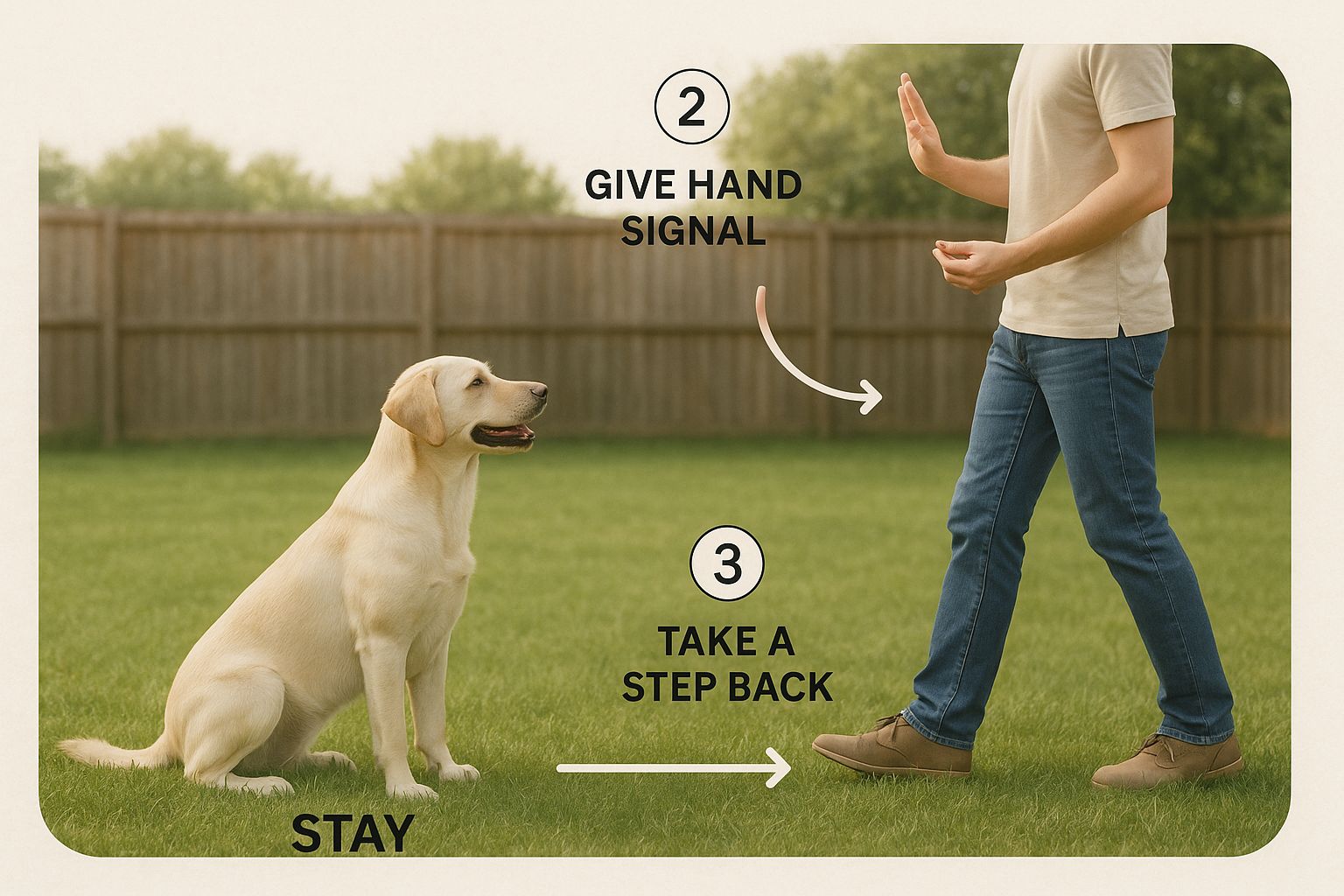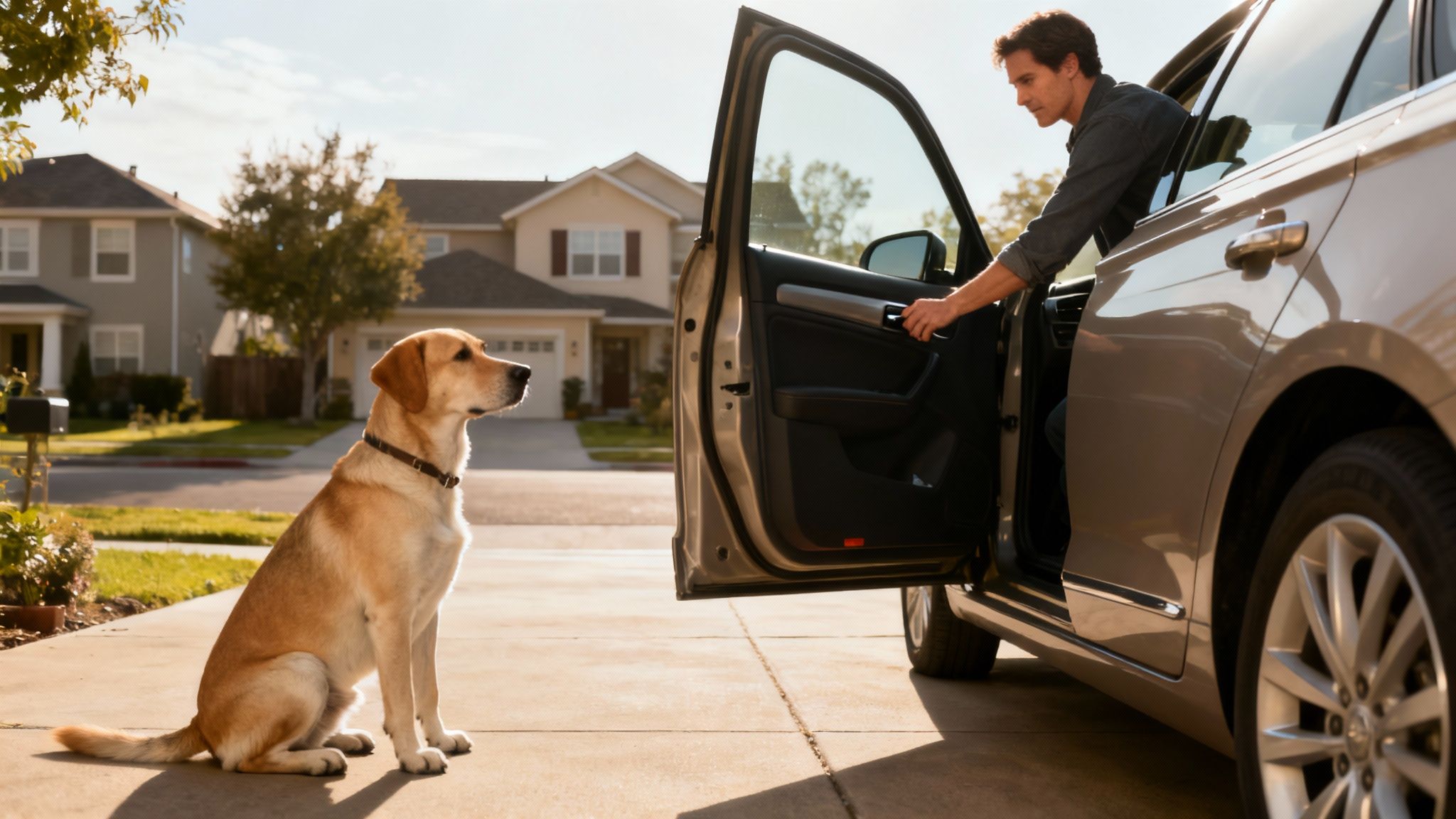Teaching your dog to ‘stay’ is one of the most powerful safety commands we can have in our toolkit. The trick is to build it up slowly—adding more time, more distance, and eventually, a few distractions. When we do this right, what could be a frustrating task becomes a fantastic bonding experience for you both.
Why Teaching Your Dog to Stay Is a Lifesaver
Has your dog ever tried to cross the road before it's safe to do so? Or even worse, pulled you over the road in front of oncoming traffic? Knowing how to train your dog to stay will keep you and your dog safe in that kind of situation and many others. That's why you really do need to know how do it and you can start learning some simple techniques here today.
More Than Just a Command
Think about the everyday situations where a reliable 'stay' is a game-changer for you and your dog:
- Roadside Safety: It stops your dog from bolting into a busy street.
- Doorway Manners: No more escaping out the front door when visitors arrive or the postman knocks.
- Emergency Control: It gives you a moment to manage them if they drop something hazardous or you spot a danger up ahead.
This single command builds a deep foundation of trust and control, making every walk safer and more enjoyable for us both. While a well-trained ‘stay’ is invaluable in a serious situation, it's also wise to be prepared for accidents. Knowing some essential dog first aid offers that extra layer of peace of mind, just in case.
Of course, a well-behaved dog also brings so much joy and creates countless memorable moments. Once you've mastered this command, you’ll have plenty of opportunities to capture that perfect picture. You could even turn your dog's photos into custom canvas art to celebrate your training success.
Setting Your Dog Up for Training Success
Before we even think about the 'stay' command, let's get the groundwork right together. A good training session isn't about fancy equipment or hours of drilling; it starts with the right environment. By laying a positive foundation, we turn learning into a game your dog actually wants to play.
First off, let's pick your training ground. Find a quiet spot inside your house where your dog feels safe and there’s not much going on – the living room or kitchen usually works well. Our goal is to minimise distractions. We're talking squirrels at the window, the kids running riot, or the sound of the postman. You want your dog’s focus entirely on you. This is a massive part of successful training; our guide to puppy training basics explains just how crucial a calm setting is.
Gather Your Simple Toolkit
You really don't need much to get going. Just a couple of things will do the trick:
- High-Value Treats: Forget the boring old kibble. You need something properly motivating. Think tiny, pea-sized bits of chicken, cheese, or hot dog – something that makes your dog’s eyes light up.
- A Positive Mindset: Honestly, this is your most powerful tool. Your dog feeds off your energy, so if you're patient and encouraging, they'll be much more willing to learn. Let's keep things light and fun.
Here in the UK, a solid 'stay' is a top priority for countless of the 13.5 million dog-owning households. The good news is that the thinking around training has really moved on. Positive reinforcement is now the preferred method, with over 50% of trainers championing reward-based approaches over the old-school, harsher techniques. It’s all about building trust, not fear. You can dig into more UK dog ownership trends in this 2025 guide.
Lastly, let's sort out our cues before you start. When you're teaching a dog anything, consistency is your best friend.
Key Takeaway: Decide on one clear verbal cue (like "Stay") and a simple hand signal (an open palm facing your dog is a classic) right from the get-go. Using the exact same word and gesture every single time cuts down on confusion and helps your dog pick it up much faster.
Mastering the Stay Command Step by Step
Right, let's get started. We're going to walk through this together, using positive reinforcement to make teaching your dog to stay a brilliant experience for both of you. The real secret? It's what professional trainers call the 'Three Ds'—Duration, Distance, and Distractions. The trick is to tackle only one at a time.
This approach stops your dog from feeling overwhelmed and, crucially, sets them up for success right from the very first attempt.
This visual shows the basic starting point: asking for a sit or down, taking a tiny step back, and rewarding them for holding their position. Simple.
The main takeaway here is to keep it incredibly simple and rewarding. We're building confidence by asking for a small, achievable action and offering an immediate, positive reward.
First Things First: Duration
To begin, we're going to focus purely on time. Ask your dog for a 'sit' or 'down'. The moment they do it, wait just one single second before you praise them and pop a treat in their mouth. It's vital to deliver the treat while they are still in position. This is how they connect the reward with the act of staying put.
Run through this a few times, sandwiching these tiny one-second pauses between instant rewards. This keeps your dog engaged and feeling like they can't get it wrong. Once they're totally comfortable with one second, try for two. Then drop back to one, then maybe push for three.
Pro Tip: Keep the timing random and unpredictable. Instead of always making it longer, mix it up. This keeps your dog guessing and stops them from breaking the stay just because they think they know what's coming next.
Nail Down Your Release Word
One of the most important parts of a reliable 'stay' is telling your dog when it’s over. A release word is your clear, consistent signal that they're free to move. Pick a short, upbeat word you don’t use in everyday chit-chat, like "Okay!", "Free!", or "Break!".
As you give the treat at the end of a successful stay, say your release word with enthusiasm. This teaches your dog that the command has a definite end, which is what prevents them from just getting up whenever they fancy it.
Building a solid stay is a core skill. If you're looking for more hands-on guidance, exploring professional dog training can offer personalised support for you and your furry friend. Trust us, consistent use of a release word is a technique every good trainer swears by.
What To Do When ‘Stay’ Goes Wrong
So what happens when your training session doesn't quite go to plan? First thing's first: let's take a deep breath. It’s a completely normal part of teaching your dog to stay, and absolutely nothing to worry about.
Every single dog breaks a stay at some point; it's just information telling us we might have gone a bit too fast for them. This is your problem-solving guide for those little hiccups. We’ll look at the most common hurdles and how you can get past them with a bit of patience and understanding.
Your Dog Immediately Gets Up
This is the classic, isn't it? You ask for a stay, take one tiny step back, and poof—they're instantly up and following you. It's not disobedience; it just means we've asked for a bit too much, a bit too soon.
When your dog breaks the stay, it’s a clear signal to make the next attempt easier. The goal is to build a long history of success, not a string of failures.
Key Takeaway: If your dog gets up, please don't get frustrated. Simply guide them back into position, or ask for another sit/down, and then reward them for an even shorter duration. Maybe just a single second. Then you can try moving again.
Handling Distractions and ‘The Creep’
Life is full of distractions, from a car door slamming outside to another dog barking down the street. When a sudden noise breaks your dog's focus, it’s a sign the environment is just too challenging for where they are in their training right now.
- Manage the Environment: We need to go back to basics in a quieter space with fewer potential surprises.
- Introduce Distractions Slowly: Once they're solid in a quiet room, have a family member walk quietly in another room. You can gradually make the distractions more obvious as your dog's confidence grows.
Another common issue is what we call 'the creep'—that slow, inch-by-inch shuffle forward. This often happens when your dog anticipates the treat and can't quite contain their excitement. To fix this, you need to go back to rewarding them for being perfectly still. Use your release word ("Okay!") just before they even think about starting to creep, and reward them for that successful, stationary stay. This reminds them that all the good things happen when their paws stay put.
Taking Your Dog's Stay into the Real World
So, your dog has nailed a solid stay in the quiet of your living room. Fantastic! Now it's time for us to take that brilliant skill where it really counts: the great outdoors. This is where all your hard work and patience start to pay off in real-world safety.
The trick is to slowly move from the house to the garden, and eventually, out onto a quiet street. We're going to 'proof' the command against all sorts of distractions, like other dogs, cyclists, or passing traffic. The goal is to gradually increase the difficulty so your dog is never set up to fail, ensuring they feel confident every step of the way.
Gradually Adding New Challenges
Your first port of call is the garden. It’s familiar territory but introduces a whole new world of sights and smells. Ask for a very short stay, just as you did indoors, and reward them generously for getting it right. Keep these sessions short, fun, and always end on a high note.
A secure area is a huge help when you're ready to practise in your back garden. This is especially true if there are potential distractions nearby. For smaller dogs, creating a dedicated dog run can offer a safe, contained space for them to focus without you worrying about them wandering off.
Once the garden stay is reliable, try moving to a quiet pavement. Start with incredibly short stays and very low expectations. The world is a distracting place, and we need to be fair to our dogs as they learn.
Our Top Tip: Always take a step back when you change the environment. If your dog can hold a stay for 30 seconds inside, aim for just five seconds the first time you try it in the garden. This helps them adjust to the new challenge without feeling overwhelmed.
Real-Life Scenarios
Now for the fun part – applying the stay command to everyday situations where it's genuinely useful for us.
- At the Car: Before letting your dog jump out, ask for a 'stay'. This simple command can stop them from bolting into a busy car park or street.
- When Visitors Arrive: A solid 'stay' on their bed prevents them from jumping all over guests at the front door. It’s a game-changer for household harmony!
- Near Roads: This is the big one. Practise asking for a 'stay' a safe distance from a quiet road, gradually building their ability to focus even with traffic nearby.
There's a reason why these skills are so sought after. The pet training services sector hit a market size of around USD 4.32 billion in 2024, which just goes to show how much we value well-behaved, safe companions. By proofing your dog's stay, you're not just teaching a trick; you're building a reliable, life-saving command you can count on anywhere.
Your Top ‘Stay’ Training Questions Answered
Got a question about teaching the 'stay' command? You're not alone. We've pulled together some of the most common queries we hear from dog owners to help you get past any sticking points.
How Long Should My Training Sessions Be?
Let's keep them short and sweet. When you're working on something as focused as the 'stay', you'll have much more success with several 3-5 minute sessions sprinkled throughout the day.
Forget about one long, drawn-out training block. Our goal is to finish up while your dog is still having a good time and getting it right. That way, they'll be excited for the next session, not dreading it.
My Dog Is Too Energetic to Stay Still, What Can I Do?
This is a classic! A dog with a case of the zoomies is never going to hold a 'stay'. We've all been there. The simple answer is that a tired dog is a trainable dog.
Before you even think about starting a 'stay' session, let's burn off some of that excess energy. A quick game of fetch in the garden or a brisk walk around the block can work wonders. It helps them get their wiggles out so they can actually concentrate on you.
A Quick Word on 'Stay' vs. 'Wait'
We often get asked about the difference. Think of 'stay' as the formal command where you might walk away or even leave the room. 'Wait', on the other hand, is more of an informal pause—like waiting for you to open the car door or before crossing a road together. It’s best to get one command absolutely solid before you start teaching the other, just to avoid any confusion.
When Can I Stop Using Treats to Reward a Stay?
Once your dog's 'stay' is looking pretty reliable, you can start to phase out giving a treat for every single success. This is where we move to what trainers call an intermittent reward schedule.
Instead of rewarding every time, you start rewarding only the best attempts. Maybe it's for holding the 'stay' longer than ever before, or for not moving an inch when the cat walks past. This element of surprise actually strengthens the behaviour because your dog never knows which 'stay' will be the one that wins the jackpot!
At K9 Time, we know that great training is all about building a brilliant bond with your dog. If you ever need a hand with walks or care in the Sheffield area, our professional, one-to-one dog walking services are here to help. Find out more about our personalised approach at https://k9time.co.uk.




